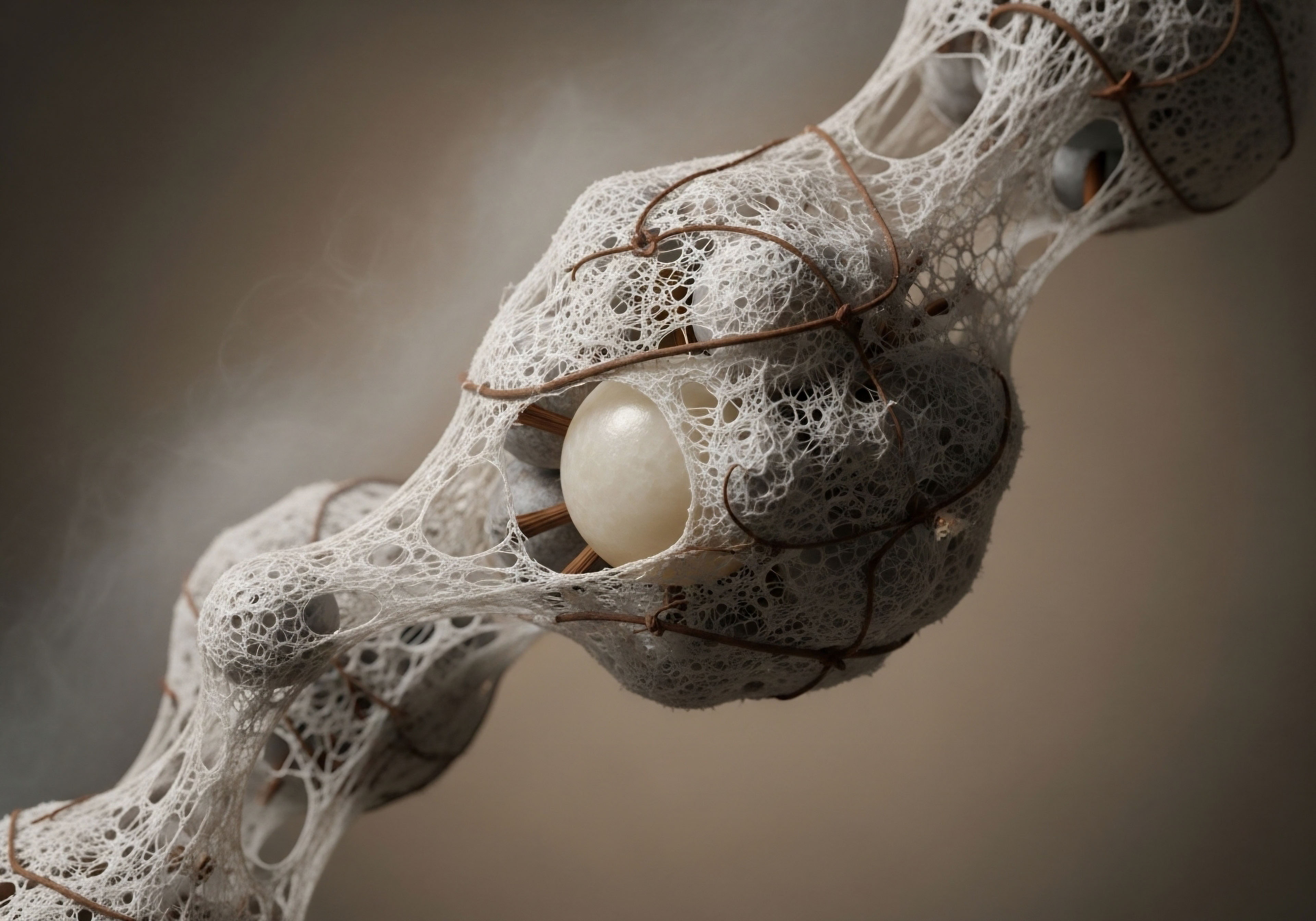

Fundamentals
Many individuals experience a subtle yet persistent shift in their overall vitality, a gradual decline in the energy and resilience that once felt innate. This often manifests as a diminished capacity for physical activity, a struggle with maintaining a healthy body composition, or even a quiet erosion of restorative sleep.
These changes are not simply an inevitable consequence of passing years; they frequently signal deeper shifts within the body’s intricate internal messaging system, particularly its hormonal balance. Understanding these underlying biological mechanisms offers a pathway to reclaiming a sense of well-being and robust function.
The body’s endocrine system operates as a sophisticated network, dispatching chemical messengers known as hormones to regulate nearly every physiological process. These messengers orchestrate everything from metabolism and mood to growth and repair. When this delicate orchestration falters, even slightly, the repercussions can be felt across various aspects of daily life. Recognizing these signals within your own experience marks the initial step toward understanding your unique biological landscape.
A decline in vitality often signals shifts within the body’s intricate hormonal balance, offering a pathway to reclaiming well-being.

The Body’s Internal Regulators
Hormones function much like a complex communication grid, with various glands acting as broadcasting stations and cells throughout the body serving as receivers. Each hormone carries a specific message, prompting cells to perform particular actions. For instance, growth hormone (GH), produced by the pituitary gland, plays a central role in cellular regeneration, tissue repair, and metabolic regulation. Its influence extends to muscle mass, bone density, and even cognitive sharpness.
As individuals age, the natural production of many hormones, including growth hormone, tends to decrease. This decline contributes to some of the common experiences associated with aging, such as reduced muscle mass, increased body fat, and a slower recovery from physical exertion. While this decline is a natural physiological process, its impact on daily function and quality of life can be significant.

Peptides as Biological Signals
Within the broader discussion of hormonal health, peptides represent a fascinating class of molecules. These are short chains of amino acids, the building blocks of proteins. Many peptides act as signaling molecules, influencing the release or activity of other hormones. Growth hormone-releasing peptides (GHRPs) and growth hormone-releasing hormones (GHRHs) are examples of such molecules.
They do not directly introduce growth hormone into the body; instead, they stimulate the pituitary gland to produce and release more of its own natural growth hormone.
This distinction is significant. Rather than replacing a hormone, these peptides encourage the body’s inherent capacity to produce more of what it needs. This approach aligns with a philosophy of supporting and recalibrating the body’s systems, rather than simply overriding them. Understanding this fundamental difference provides a clearer perspective on how these therapeutic agents operate within the complex biological framework.

Supporting Endogenous Production
The concept of supporting endogenous production, meaning the body’s own natural creation of substances, is a cornerstone of personalized wellness protocols. When considering options like growth hormone peptide therapy, the aim is to gently nudge the body’s own mechanisms back into a more optimal state. This contrasts with direct hormone replacement, which introduces external hormones. Both approaches have their place, but the former often seeks to restore a more youthful physiological rhythm.
This method of encouraging the body’s own processes can lead to more balanced and sustained effects, as the body retains control over the amount and timing of hormone release. It is a subtle yet powerful way to influence the intricate feedback loops that govern hormonal regulation, promoting a more harmonious internal environment.


Intermediate
For individuals seeking to optimize their physiological function, the integration of various hormonal support protocols presents a compelling avenue. Growth hormone peptide therapy, rather than existing in isolation, can become a synergistic component within a broader strategy for endocrine system support. This approach recognizes that the body’s hormonal systems are deeply interconnected, and addressing one aspect often influences others.
The careful orchestration of these protocols requires a precise understanding of their mechanisms and how they interact. The goal is to create a comprehensive biochemical recalibration that addresses individual needs, moving beyond single-point interventions to a more holistic restoration of vitality.
Integrating growth hormone peptide therapy with other hormonal protocols creates a synergistic approach to endocrine system support.

Growth Hormone Peptide Protocols
Growth hormone peptide therapy utilizes specific peptides to stimulate the pituitary gland’s natural production of growth hormone. These agents act on different receptors within the pituitary, leading to a pulsatile release of GH that mimics the body’s physiological rhythm.
- Sermorelin ∞ This peptide is a synthetic analog of growth hormone-releasing hormone (GHRH). It stimulates the pituitary to release GH in a natural, pulsatile manner, promoting cellular repair and metabolic balance.
- Ipamorelin / CJC-1295 ∞ Ipamorelin is a selective growth hormone secretagogue, meaning it specifically triggers GH release without significantly affecting other hormones like cortisol or prolactin. CJC-1295 is a GHRH analog that provides a sustained release of GH, often combined with Ipamorelin for enhanced effects.
- Tesamorelin ∞ Primarily known for its role in reducing visceral fat, Tesamorelin is a modified GHRH that also stimulates GH production, contributing to improved body composition.
- Hexarelin ∞ A potent GHRP, Hexarelin stimulates GH release and has shown potential benefits in cardiovascular health and tissue repair.
- MK-677 ∞ This is an orally active growth hormone secretagogue that increases GH and IGF-1 levels by mimicking the action of ghrelin, a natural hunger hormone.
These peptides are typically administered via subcutaneous injections, often on a daily or several-times-weekly schedule, tailored to the individual’s specific goals and physiological response. The precise dosing and selection of peptides depend on factors such as age, health status, and desired outcomes, whether it is for improved body composition, enhanced recovery, or general well-being.

Testosterone Optimization for Men
For men experiencing symptoms of low testosterone, or andropause, testosterone replacement therapy (TRT) can significantly improve energy, mood, libido, and muscle mass. Integrating TRT with growth hormone peptide therapy can offer a more comprehensive approach to male hormonal health.
A standard TRT protocol often involves weekly intramuscular injections of Testosterone Cypionate (200mg/ml). To maintain the body’s natural testosterone production and preserve fertility, Gonadorelin is frequently included, administered via subcutaneous injections twice weekly. This agent stimulates the pituitary to release luteinizing hormone (LH) and follicle-stimulating hormone (FSH), which are crucial for testicular function.
Additionally, Anastrozole, an oral tablet taken twice weekly, may be prescribed to manage estrogen conversion, preventing potential side effects associated with elevated estrogen levels. In some cases, Enclomiphene might be added to further support LH and FSH levels, particularly for men concerned with fertility.

Can Hormonal Protocols Be Tailored for Individual Needs?
The personalization of hormonal protocols is paramount. Each individual’s endocrine system responds uniquely, necessitating a flexible and adaptive approach to therapy. This means that while standard protocols exist, they serve as a starting point for a finely tuned regimen.
| Agent | Primary Role | Typical Administration |
|---|---|---|
| Testosterone Cypionate | Testosterone replacement | Weekly intramuscular injection |
| Gonadorelin | Stimulates natural testosterone production, fertility support | 2x/week subcutaneous injection |
| Anastrozole | Estrogen management | 2x/week oral tablet |
| Sermorelin | Stimulates natural growth hormone release | Daily subcutaneous injection |
| Ipamorelin / CJC-1295 | Potent growth hormone release | Daily subcutaneous injection |

Female Hormonal Balance
Women also experience significant hormonal shifts, particularly during peri-menopause and post-menopause, which can lead to symptoms such as irregular cycles, mood changes, hot flashes, and diminished libido. Hormonal optimization protocols for women often involve a careful balance of testosterone and progesterone.
For women, Testosterone Cypionate is typically administered in much lower doses, often 10 ∞ 20 units (0.1 ∞ 0.2ml) weekly via subcutaneous injection. This low-dose approach aims to restore optimal testosterone levels without masculinizing side effects, addressing symptoms like low libido and fatigue. Progesterone is prescribed based on menopausal status, playing a crucial role in uterine health and mood regulation.
For some, pellet therapy, which involves long-acting testosterone pellets inserted subcutaneously, offers a convenient alternative, with Anastrozole considered when appropriate to manage estrogen levels.
The interplay between growth hormone and sex hormones is a critical consideration. Optimal levels of testosterone and estrogen can enhance the benefits derived from growth hormone peptide therapy, as these hormones collectively influence cellular repair, metabolic rate, and overall tissue health. A comprehensive approach acknowledges these synergistic relationships.


Academic
The integration of growth hormone peptide therapy within broader hormonal optimization protocols necessitates a deep understanding of the intricate neuroendocrine axes that govern human physiology. This systems-biology perspective reveals how interventions in one hormonal pathway can exert pleiotropic effects across multiple biological domains, underscoring the importance of a coordinated therapeutic strategy. The primary focus here centers on the interplay between the somatotropic axis (GH/IGF-1) and the gonadal axis (HPG axis), alongside their metabolic ramifications.
The somatotropic axis, comprising the hypothalamus, pituitary, and liver, orchestrates the production and action of growth hormone and its primary mediator, Insulin-like Growth Factor 1 (IGF-1). Growth hormone-releasing peptides (GHRPs) and growth hormone-releasing hormones (GHRHs) act on distinct receptors within the anterior pituitary to stimulate GH secretion.
For instance, GHRH analogs like Sermorelin and Tesamorelin bind to the GHRH receptor, activating the cAMP/PKA pathway, which promotes GH synthesis and release. Conversely, GHRPs such as Ipamorelin and Hexarelin bind to the ghrelin receptor (GHS-R1a), leading to increased intracellular calcium and subsequent GH exocytosis. The pulsatile nature of GH release, which these peptides aim to mimic, is critical for optimal physiological effects, preventing receptor desensitization.
Understanding the intricate neuroendocrine axes is crucial for integrating growth hormone peptide therapy with other hormonal optimization protocols.

Interactions between Somatotropic and Gonadal Axes
A compelling aspect of integrated hormonal optimization lies in the reciprocal regulation between the somatotropic and gonadal axes. Sex steroids, particularly testosterone and estrogen, significantly influence GH secretion and IGF-1 bioavailability. In men, testosterone can upregulate GHRH receptor expression in the pituitary and enhance GH pulsatility. Conversely, hypogonadism often correlates with reduced GH secretion and lower IGF-1 levels, contributing to symptoms such as decreased muscle mass and increased adiposity.
For women, estrogen plays a complex role. While physiological estrogen levels can enhance GH secretion, supraphysiological levels, particularly from oral estrogen replacement, can reduce IGF-1 bioavailability by increasing hepatic production of IGF-binding proteins (IGFBPs), primarily IGFBP-1 and IGFBP-3.
This highlights the importance of precise dosing and administration routes in female hormonal optimization, favoring transdermal or subcutaneous estrogen when appropriate to bypass first-pass hepatic metabolism. The concurrent administration of growth hormone peptides with sex steroid optimization aims to create a synergistic environment where both axes function more effectively, promoting tissue anabolism and metabolic efficiency.

Metabolic and Cellular Implications
The metabolic impact of integrating these therapies is substantial. Growth hormone and IGF-1 are potent regulators of glucose and lipid metabolism. GH directly promotes lipolysis and can induce insulin resistance at high doses, while IGF-1 acts as an insulin sensitizer. The balance between these effects is critical. Optimized testosterone levels in men are associated with improved insulin sensitivity and reduced visceral adiposity. Similarly, balanced estrogen and progesterone levels in women contribute to metabolic stability.
When growth hormone peptide therapy is combined with testosterone replacement therapy, for example, the combined anabolic and metabolic effects can be profound. Testosterone promotes muscle protein synthesis and fat oxidation, while GH and IGF-1 contribute to cellular repair, collagen synthesis, and overall tissue regeneration. This dual action can lead to enhanced body composition, improved exercise capacity, and accelerated recovery from physical stress.
| Hormonal Axis | Key Hormones | Influence on Other Axes | Metabolic Outcomes |
|---|---|---|---|
| Somatotropic Axis | GH, IGF-1 | Influences HPG axis activity | Lipolysis, protein synthesis, glucose regulation |
| Hypothalamic-Pituitary-Gonadal (HPG) Axis | Testosterone, Estrogen, Progesterone | Influences GH secretion and IGF-1 bioavailability | Insulin sensitivity, body composition, bone density |
| Thyroid Axis | Thyroid Hormones (T3, T4) | Modulates GH secretion and action | Basal metabolic rate, energy expenditure |

Clinical Considerations and Monitoring
The successful integration of growth hormone peptide therapy with other hormonal optimization protocols hinges on meticulous clinical assessment and ongoing monitoring. Baseline laboratory evaluations should include comprehensive hormonal panels (e.g. total and free testosterone, estradiol, LH, FSH, IGF-1, thyroid hormones), metabolic markers (e.g. fasting glucose, HbA1c, lipid panel), and inflammatory markers. Regular follow-up assessments are essential to titrate dosages, manage potential side effects, and ensure therapeutic efficacy.
For instance, while growth hormone peptides generally have a favorable safety profile due to their physiological mechanism of action, monitoring IGF-1 levels is important to ensure they remain within a healthy, age-appropriate range. Similarly, in men undergoing TRT, estradiol levels must be carefully managed with agents like Anastrozole to prevent estrogenic side effects such as gynecomastia or water retention. The overarching goal is to restore physiological balance, not to achieve supraphysiological levels that could carry undue risks.

How Do Hormonal Optimization Protocols Influence Longevity?
The long-term implications of integrated hormonal optimization protocols extend beyond symptom management to potential influences on healthspan and longevity. By restoring more youthful hormonal profiles, these therapies may mitigate age-related decline in tissue function, metabolic health, and cognitive resilience.
Research continues to explore the precise mechanisms by which optimal hormonal balance contributes to healthy aging, but the systemic benefits observed in clinical practice suggest a compelling connection. This approach represents a proactive stance toward maintaining robust physiological function throughout the lifespan.

References
- Vance, Mary Lee, and Michael O. Thorner. “Growth Hormone-Releasing Hormone.” Endocrine Reviews, vol. 13, no. 3, 1992, pp. 347-362.
- Frohman, Lawrence A. and J. L. Kineman. “Growth Hormone-Releasing Hormone and Its Receptor ∞ Current Status and Future Perspectives.” Frontiers in Neuroendocrinology, vol. 24, no. 2, 2003, pp. 100-112.
- Svensson, J. et al. “Growth Hormone Secretagogues.” Journal of Endocrinology, vol. 182, no. 2, 2004, pp. 205-219.
- Karakas, Seyfettin E. “Growth Hormone and Aging.” Clinical Interventions in Aging, vol. 2, no. 3, 2007, pp. 315-322.
- Bhasin, Shalender, et al. “Testosterone Therapy in Men With Androgen Deficiency Syndromes ∞ An Endocrine Society Clinical Practice Guideline.” Journal of Clinical Endocrinology & Metabolism, vol. 95, no. 6, 2010, pp. 2536-2559.
- Davis, Susan R. et al. “Global Consensus Position Statement on the Use of Testosterone Therapy for Women.” Journal of Clinical Endocrinology & Metabolism, vol. 104, no. 10, 2019, pp. 4660-4666.
- Sigalos, John T. and Ranjith Ramasamy. “Testosterone Therapy and Male Infertility.” Translational Andrology and Urology, vol. 5, no. 5, 2016, pp. 610-619.
- Yuen, Kevin C. J. et al. “Growth Hormone and Insulin-Like Growth Factor-1 in Clinical Practice ∞ A Review.” Clinical Endocrinology, vol. 75, no. 1, 2011, pp. 1-10.
- Boron, Walter F. and Emile L. Boulpaep. Medical Physiology. 3rd ed. Elsevier, 2017.
- Guyton, Arthur C. and John E. Hall. Textbook of Medical Physiology. 13th ed. Elsevier, 2016.

Reflection
Considering your personal health journey, the knowledge gained about hormonal systems and their intricate connections is not merely information; it represents a foundational understanding. This awareness empowers you to engage more deeply with your own biological systems. The path to reclaiming vitality is a unique one for each individual, requiring a thoughtful, personalized approach rather than a one-size-fits-all solution.
Understanding how growth hormone peptides interact with other hormonal optimization protocols provides a clearer map for navigating your options. This journey is about listening to your body’s signals, interpreting them through a scientific lens, and then making informed choices that align with your aspirations for sustained well-being. Your capacity to influence your own health trajectory is substantial, beginning with this deeper appreciation of your internal landscape.



